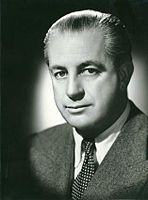Australian federal election, 1966
|
|
||||||||||||||||||||||||||||||||||
|---|---|---|---|---|---|---|---|---|---|---|---|---|---|---|---|---|---|---|---|---|---|---|---|---|---|---|---|---|---|---|---|---|---|---|
|
||||||||||||||||||||||||||||||||||
|
All 124 seats of the Australian House of Representatives 63 seats were needed for a majority |
||||||||||||||||||||||||||||||||||
|
||||||||||||||||||||||||||||||||||
|
||||||||||||||||||||||||||||||||||
Harold Holt
Liberal/Country coalition
Harold Holt
Liberal/Country coalition
Federal elections were held in Australia on 26 November 1966. All 124 seats in the House of Representatives were up for election. The incumbent Liberal Party of Australia, led by Prime Minister of Australia Harold Holt, with coalition partner the Country Party, led by John McEwen, was elected to an eighth term in government, defeating the Australian Labor Party led by Arthur Calwell.
The election was a landslide win for the Coalition, which won twice as many seats as Labor. Holt's victory was greater than any of Menzies', and it was seen as the high point of both his Prime Ministership and the 23 years of continuous Coalition rule.
Independents: Sam Benson
The new Prime Minister, Harold Holt, was stylish, debonair and popular with the electorate. He cast a sharp contrast with the much rougher figure of Arthur Calwell, who had already lost two elections. Calwell held to the beliefs that had been central to the last Labor Government of 1941–1949, many of which were seen as being old-fashioned in 1966. For example, he was a defender of the White Australia Policy, nationalization. He also came across poorly on television compared to Holt, and looked and sounded older than his 70 years.
In addition, a strong economy and initial enthusiasm for Australia's involvement in the Vietnam War virtually guaranteed the Coalition the election who campaigned with the slogan "Keep Australia secure and prosperous – play it safe". Calwell retired a month after the election and was succeeded by Deputy Labor leader Gough Whitlam.
...
Wikipedia


